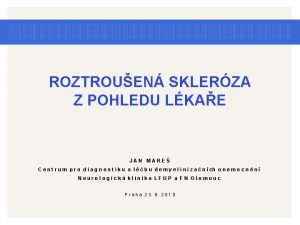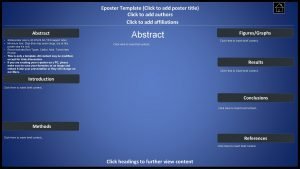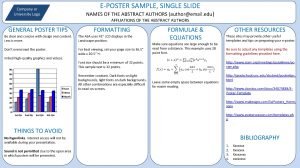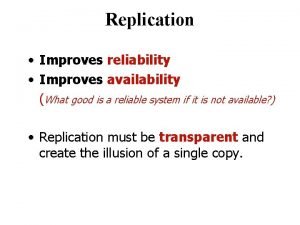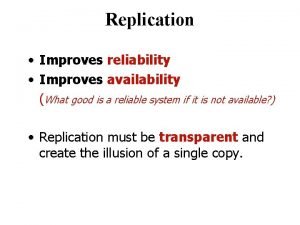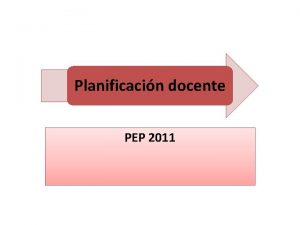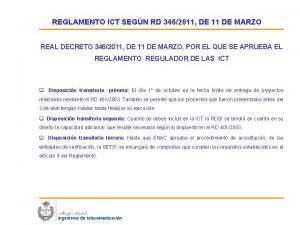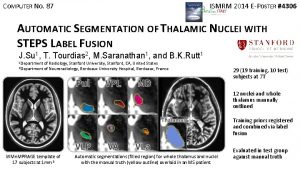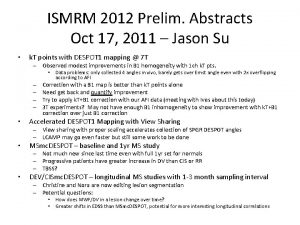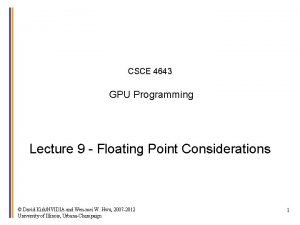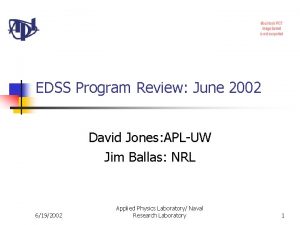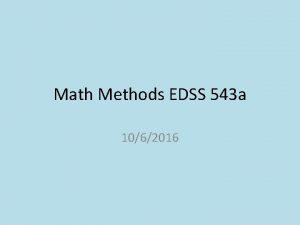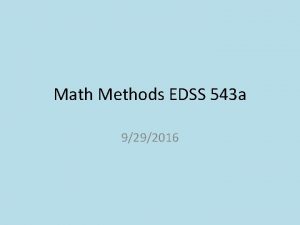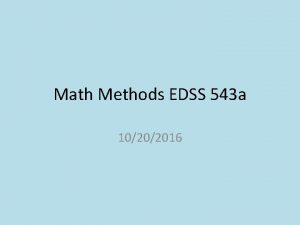ISMRM 2011 EPOSTER 4643 MCDESPOTDERIVED MWF IMPROVES EDSS



























- Slides: 27

ISMRM 2011 E-POSTER #4643 MCDESPOT-DERIVED MWF IMPROVES EDSS PREDICTION IN MS PATIENTS COMPARED TO ATROPHY MEASURES ALONE J. Su 1, H. H. Kitzler 2, M. Zeineh 1, S. C. Deoni 3, C. Harper-Little 2, A. Leung 2, M. Kremenchutzky 2, and B. K. Rutt 1 1 Stanford U, CA, USA, 2 TU Dresden, SN, Germany, 2 U of Western Ontario, ON, Canada, 3 Brown U, RI, USA Declaration of Conflict of Interest or Relationship I have no conflicts of interest to disclose with regard to the subject matter of this presentation.

MCDESPOT-DERIVED MWF IMPROVES EDSS PREDICTION IN MS PATIENTS COMPARED TO ATROPHY MEASURES ALONE ISMRM 2011 #4643 Background • Conventional MRI measures such as lesion load have been criticized with adding little new information on top of clinical scores for multiple sclerosis (MS) patients • Measures that quantify the hidden burden of disease in white matter are urgently needed

MCDESPOT-DERIVED MWF IMPROVES EDSS PREDICTION IN MS PATIENTS COMPARED TO ATROPHY MEASURES ALONE ISMRM 2011 #4643 Purpose • To apply mc. DESPOT, a whole-brain, myelinselective, multi-component relaxometric imaging method, in a pilot MS study • Assess if the method can explain differences in disease course and severity by uncovering the burden of disease in normal-appearing white matter (NAWM)

MCDESPOT-DERIVED MWF IMPROVES EDSS PREDICTION IN MS PATIENTS COMPARED TO ATROPHY MEASURES ALONE ISMRM 2011 #4643 Study Healthy Controls All Patients CIS RRMS SPMS PPMS N 26 26 10 5 6 5 Mean age, yr (SD) 42 49 41 48 58 55 (13) (12) (7) 10/16 7/19 3/7 0/5 0/6 4/1 14 2 15 28 20 (13) (2) (10) (8) (12) 3. 6 1. 7 2. 0 6. 4 5. 6 (2. 4) (0. 9) (1. 7) (1. 1) Demographic Data Male/Female ratio Mean disease duration, yr (SD) Mean EDSS score (SD) — —

MCDESPOT-DERIVED MWF IMPROVES EDSS PREDICTION IN MS PATIENTS COMPARED TO ATROPHY MEASURES ALONE ISMRM 2011 #4643 Scanning Methods • 1. 5 T GE Signa HDx, 8 -channel head RF coil • mc. DESPOT: 2 mm 3 isotropic covering whole brain, about 15 min. – SPGR: TE/TR = 2. 1/6. 7 ms, α = {3, 4, 5, 6, 7, 8, 11, 13, 18}° – b. SSFP: TE/TR = 1. 8/3. 6 ms, α = {11, 14, 20, 24, 28, 34, 41, 51, 67}° • 2 D T 2 FLAIR: 0. 86 mm 2 in-plane and 3 mm slice resolution • 3 D T 1 IR-SPGR: 1 mm 3 resolution with pre/post Gd contrast

The Technique

MCDESPOT-DERIVED MWF IMPROVES EDSS PREDICTION IN MS PATIENTS COMPARED TO ATROPHY MEASURES ALONE ISMRM 2011 #4643 Processing Methods: MWF • Linearly coregister and brain extract mc. DESPOT SPGR and SSFP images with FSL 1 Myelin Water Fraction • Find myelin water fraction maps using the established mc. DESPOT fitting algorithm 2 1 FMRIB Software Library. 2 Deoni et al. , Magn Reson Med. 2008 Dec; 60(6): 1372 -87

mc. DESPOT Maps in Normal T 1 single T 1 slow T 1 fast MWF 0 – 2345 ms 0 – 1172 ms 0 – 555 ms 0 – 0. 234 0 – 328 ms 0 – 123 ms 0 – 9. 26 ms 0 – 137 ms T 2 single T 2 slow T 2 fast Residence Time

MCDESPOT-DERIVED MWF IMPROVES EDSS PREDICTION IN MS PATIENTS COMPARED TO ATROPHY MEASURES ALONE ISMRM 2011 #4643 Processing Methods: Demyelination • Non-linearly register mc. DESPOT MWF maps to MNI 152 standard space • Combine normals together to form mean and standard deviation MWF volumes • For each subject, calculate a z-score ([x – μ]/σ) at every voxel to determine if it is significantly demyelinated, i. e. MWF < -4σ below the mean Demyelinated Voxels

MCDESPOT-DERIVED MWF IMPROVES EDSS PREDICTION IN MS PATIENTS COMPARED TO ATROPHY MEASURES ALONE ISMRM 2011 #4643 Processing Methods: WM • Brain extract MPRAGE images • Segment white and gray matter with SPM 83 • Filter tissue masks to reduce noise then manually edit by a trained neuroradiologist • Calculate parenchymal volume fraction (PVF) as WM+GM divided by the brain mask volume 3 Statistical Parametric Mapping software package. FLAIR WM

MCDESPOT-DERIVED MWF IMPROVES EDSS PREDICTION IN MS PATIENTS COMPARED TO ATROPHY MEASURES ALONE ISMRM 2011 #4643 Processing Methods: Lesions & DAWM • Non-linearly register T 2 -FLAIR images to MNI 152 standard space • Combine normals together to form mean and standard deviation volumes • Segment lesions as those voxels with z-score > +4 and diffusely abnormal white matter > +2 • Edit masks by a trained neurologist DAWM Lesions

MCDESPOT-DERIVED MWF IMPROVES EDSS PREDICTION IN MS PATIENTS COMPARED TO ATROPHY MEASURES ALONE ISMRM 2011 #4643 Processing Methods: NAWM & DVF • Segment normal-appearing white matter (NAWM) as WM – DAWM – lesions • Find demyelinated volume fraction (DVF) – Sum the volume of demyelinated voxels in each tissue compartment and normalize by the compartment’s volume – # demy. voxels in compartment * voxel volume / compartment volume Normal-Appearing White Matter

MCDESPOT-DERIVED MWF IMPROVES EDSS PREDICTION IN MS PATIENTS COMPARED TO ATROPHY MEASURES ALONE ISMRM 2011 #4643 Segmentations and DV FLAIR WM NAWM DAWM Lesions MWF Demyelinated Voxels DV in NAWM DV in DAWM DV in Lesions

MCDESPOT-DERIVED MWF IMPROVES EDSS PREDICTION IN MS PATIENTS COMPARED TO ATROPHY MEASURES ALONE ISMRM 2011 #4643 Statistical Methods • Use rank sum tests to compare patient groups to normals along different measures • Perform an exhaustive search to find the best multiple linear regression model for EDSS using Mallows’ Cp 4 criterion among 21 possible image-derived predictors: – PVF – log-DVF in whole brain, log-DVF in WM, log-DVF in NAWM, log-DVF in lesions – log-DV in those four compartments – mean MWF in those four compartments – volumes of those four compartments (lesion volume = T 2 lesion load) – volume fractions of those four compartments with respect to the whole brain mask volume 4 Mallows C. Some comments on Cp. Technometrics. 1973; 15(4): 661 -75.

MCDESPOT-DERIVED MWF IMPROVES EDSS PREDICTION IN MS PATIENTS COMPARED TO ATROPHY MEASURES ALONE ISMRM 2011 #4643 Results: Mean MWF in Compartments • Dotted line shows mean MWF in WM for normals. Rank sum testing was done for each bar against this • Testing was also done for RRMS vs. SPMS and CIS vs. RRMS, any significant differences are shown with a connecting bracket • Significance levels: * p < 0. 05 ** p < 0. 01 *** p < 0. 001.

MCDESPOT-DERIVED MWF IMPROVES EDSS PREDICTION IN MS PATIENTS COMPARED TO ATROPHY MEASURES ALONE ISMRM 2011 #4643 Results: DVF in Compartments • Dotted line shows demyelinated volume fraction in WM for healthy controls • With DVF, all patient subclasses were significantly different from healthy controls • PVF, however, fails to distinguish CIS and RR patients from normals

MCDESPOT-DERIVED MWF IMPROVES EDSS PREDICTION IN MS PATIENTS COMPARED TO ATROPHY MEASURES ALONE ISMRM 2011 #4643 Results: Correlations with EDSS • Lesion load correlates poorly with EDSS • PVF and DVF are stronger indicators of decline

MCDESPOT-DERIVED MWF IMPROVES EDSS PREDICTION IN MS PATIENTS COMPARED TO ATROPHY MEASURES ALONE ISMRM 2011 #4643 Results: Multiple Linear Regression • The best linear model for EDSS contains PVF (p < 0. 001), mean MWF in whole brain (p < 0. 001), and WM volume fraction (p < 0. 01) • Whole-brain MWF and WM volume fraction significantly improve the prediction of EDSS over that produced by PVF alone • Explains 76% of the variance in EDSS (R 2 = 0. 76, adjusted R 2 = 0. 73) compared to 56% with only PVF

MCDESPOT-DERIVED MWF IMPROVES EDSS PREDICTION IN MS PATIENTS COMPARED TO ATROPHY MEASURES ALONE ISMRM 2011 #4643 Discussion & Conclusions • DVF is able to differentiate CIS and RRMS patients from normals, whereas other measures such as PVF and mean MWF cannot • The invisible burden of disease may be more important than lesions in determining disability, since we observe a higher correlation of EDSS with DVF in NAWM than lesion load • A combination of established atrophy measures with new mc. DESPOT-derived MWF are more capable in accurately estimating disability than either quantity alone

ISMRM 2011 E-POSTER #7224 SENSITIVE DETECTION OF MYELINATION CHANGE IN MULTIPLE SCLEROSIS BY MCDESPOT J. Su 1, H. H. Kitzler 2, M. Zeineh 1, S. C. Deoni 3, C. Harper-Little 2, A. Leung 2, M. Kremenchutzky 2, and B. K. Rutt 1 1 Stanford U, CA, USA, 2 TU Dresden, SN, Germany, 2 U of Western Ontario, ON, Canada, 3 Brown U, RI, USA Declaration of Conflict of Interest or Relationship I have no conflicts of interest to disclose with regard to the subject matter of this presentation.

SENSITIVE DETECTION OF MYELINATION CHANGE IN MULTIPLE SCLEROSIS BY MCDESPOT ISMRM 2011 #7224 Purpose • To apply mc. DESPOT, a whole-brain, myelinselective, multi-component relaxometric imaging method, in a 1 -year longitudinal pilot MS study • Assess the ability of the method to sense different rates of demyelination for different MS courses and compare it to changes in EDSS

SENSITIVE DETECTION OF MYELINATION CHANGE IN MULTIPLE SCLEROSIS BY MCDESPOT ISMRM 2011 #7224 Study Healthy Controls All Patients CIS RRMS SPMS PPMS N at baseline 26 26 10 5 6 5 N at 1 -year 4 23 9 4 6 4 Mean age at baseline, yr (SD) 42 49 41 48 58 55 (13) (12) (7) 14 2 15 28 20 (13) (2) (10) (8) (12) 3. 6 1. 7 2. 0 6. 4 5. 6 (2. 4) (0. 9) (1. 7) (1. 1) 3 1 0 0 2 Demographic Data Mean disease duration at baseline, yr (SD) — Mean EDSS score at baseline (SD) — N with EDSS change —

SENSITIVE DETECTION OF MYELINATION CHANGE IN MULTIPLE SCLEROSIS BY MCDESPOT ISMRM 2011 #7224 Processing Methods: 1 -year & DVF • At 1 -year, demyelinated voxels are based on zscores with respect to the combined baseline and 1 -year normal group • Find demyelinated volume fraction (DVF) – Sum the volume of demyelinated voxels and normalize by brain mask volume – # demy. voxels in compartment * voxel volume / compartment volume

SENSITIVE DETECTION OF MYELINATION CHANGE IN MULTIPLE SCLEROSIS BY MCDESPOT ISMRM 2011 #7224 Results: Mean MWF in Whole Brain • Dotted line shows mean MWF for normals. Rank sum testing was done for each bar against this value • Testing was also done for RRMS vs. SPMS and CIS vs. RRMS, any significant differences are shown with a connecting bracket • Significance levels: – * p < 0. 05 – ** p < 0. 01 – *** p < 0. 001.

SENSITIVE DETECTION OF MYELINATION CHANGE IN MULTIPLE SCLEROSIS BY MCDESPOT ISMRM 2011 #7224 Results: DVF Change • Colors denote subject type PPMS • Arrowheads indicate the direction of change and the DVF at 1 -year • Dashed lines show subjects who also had a change in EDSS SPMS RRMS CIS Normals

SENSITIVE DETECTION OF MYELINATION CHANGE IN MULTIPLE SCLEROSIS BY MCDESPOT ISMRM 2011 #7224 Results: DVF in Whole Brain • Dotted line shows mean demyelinated volume fraction change for normals • Definite MS patients are losing significantly more myelin than normals • Progressive patients have a greater rate of demyelination

SENSITIVE DETECTION OF MYELINATION CHANGE IN MULTIPLE SCLEROSIS BY MCDESPOT ISMRM 2011 #7224 Discussion & Conclusions • The normal pool at 1 -year is currently too small to show significance for the changes in mean MWF • DVF, however, is sensitive enough to show statistically significant changes in brain myelination over the study period • Progressive patients show greater disease decline that are not reflected in their EDSS disability score • EDSS and DVF measure different aspects of the disease. Patients with changes in EDSS did not actually have the largest demyelination changes
 Edss skala
Edss skala Roztroušená skleróza příznaky
Roztroušená skleróza příznaky What is e-poster
What is e-poster Eposter template
Eposter template Eposter examples
Eposter examples Eposter sample
Eposter sample 7 proper keyboarding techniques
7 proper keyboarding techniques Replication improves the reliability of the system
Replication improves the reliability of the system Advantages and disadvantages of social computing
Advantages and disadvantages of social computing Replication improves the reliability of the system
Replication improves the reliability of the system What is draw frame
What is draw frame Afs 2011 19
Afs 2011 19 Calendrier vaccinal 2011
Calendrier vaccinal 2011 Pep 2011
Pep 2011 Sla 2011
Sla 2011 Sia 2011
Sia 2011 Pasal 7 uu no 12 tahun 2011
Pasal 7 uu no 12 tahun 2011 Wyd 2011 madrid
Wyd 2011 madrid Boardworks ltd 2011
Boardworks ltd 2011 Isced codes
Isced codes Unieważnienie matury 2011
Unieważnienie matury 2011 Pada tanggal 1 april 2011 cv seneng makmur
Pada tanggal 1 april 2011 cv seneng makmur Pearson education inc publishing
Pearson education inc publishing What is a haiku poem
What is a haiku poem Rd 346 2011
Rd 346 2011 Supra 2011
Supra 2011 Elemen merentas kurikulum in english
Elemen merentas kurikulum in english Perfil de egreso de primer grado de primaria 2011
Perfil de egreso de primer grado de primaria 2011

